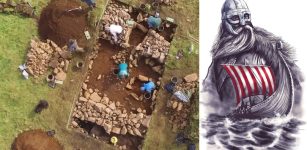Unknown Neanderthal Lineage Discovered In “Thorin” Who Lived 50,000 Years Ago
Jan Bartek - AncientPages.com - A fossilized Neanderthal discovered in a cave system in the Rhône Valley, France, represents an ancient and previously undescribed lineage. This lineage diverged from other known Neanderthals around 100,000 years ago and remained genetically isolated for over 50,000 years.
Genomic analysis indicates that this Neanderthal, nicknamed "Thorin" after the Tolkien character, lived between 42,000 and 50,000 years ago in a small, isolated community. The discovery could provide insights into the reasons behind the species' extinction and suggests that late Neanderthals had more population structure than previously understood.
"Until now, the story has been that at the time of the extinction, there was just one Neanderthal population that was genetically homogeneous, but now we know that there were at least two populations present at that time," says first author and population geneticist Tharsika Vimala of the University of Copenhagen.
"The Thorin population spent 50,000 years without exchanging genes with other Neanderthal populations," says co-first author and discoverer of Thorin, Ludovic Slimak, CNRS researcher of Université Toulouse Paul Sabatier.
"We thus have 50 millennia during which two Neanderthal populations, living about ten days' walk from each other, coexisted while completely ignoring each other. This would be unimaginable for a Sapiens and reveals that Neanderthals must have biologically conceived our world very differently from us Sapiens."
Thorin's fossilized remains were first unearthed in 2015 in Grotte Mandrin, a well-researched cave system that also housed early Homo sapiens, albeit at different times. His excavation is ongoing.
Based on his position within the cave's sediment layers, archaeologists estimated that Thorin lived approximately 40,000–45,000 years ago, classifying him as a "late Neanderthal." To determine his exact age and relationships with other Neanderthals, the team extracted DNA from his teeth and jawbone and compared his complete genome sequence to previously sequenced Neanderthal genomes.
Interestingly, the initial genomic analysis indicated that Thorin might be much older than initially thought. His genome was significantly distinct from other late Neanderthals and closely resembled those of Neanderthals who lived over 100,000 years ago.
"We worked for seven years to find out who was wrong—archaeologists or genomicists," says Slimak.
To resolve this puzzle, researchers conducted isotopic analyses on Thorin's bones and teeth to understand the climate he lived in. Late Neanderthals inhabited Ice Age conditions, while earlier ones experienced warmer climates. The isotopic results confirmed that Thorin lived in a very cold climate, consistent with being a late Neanderthal.
"This genome is a remnant of some of the earliest Neanderthal populations in Europe," says population geneticist and senior author Martin Sikora of the University of Copenhagen. "The lineage leading to Thorin would have separated from the lineage leading to the other late Neanderthals around 105,000 years ago."
Compared to previously sequenced Neanderthal genomes, Thorin's genome most closely resembled an individual excavated in Gibraltar, and Slimak speculates that Thorin's population migrated to France from Gibraltar.
Fossilized Neanderthal Thorin. Credit: Ludovik Slimak
"This means there was an unknown Mediterranean population of Neanderthals whose population spanned from the most western tip of Europe all the way to the Rhône Valley in France," says Slimak.
Knowing that Neanderthal communities were small and insular could be key to understanding their extinction because isolation is generally considered a disadvantage for population fitness.
"It's always a good thing for a population to be in contact with other populations," says Vimala. "When you are isolated for a long time, you limit the genetic variation that you have, which means you have less ability to adapt to changing climates and pathogens, and it also limits you socially because you're not sharing knowledge or evolving as a population."
However, to really understand how Neanderthal populations were structured and why they went extinct, the researchers say that more Neanderthal genomes need to be sequenced.
"I would guess that if we had more genomes from other regions during this similar time period, we would probably find other deeply structured populations," says Sikora.
The study was published in the journal Cell Genomics
Written by Jan Bartek - AncientPages.com Staff Writer






















